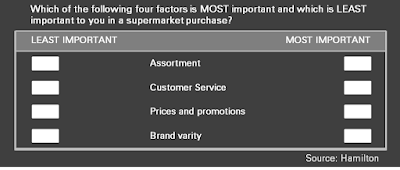Maximum Difference Scaling, també anomenat Best-Worst Scaling, és approach per understanding la preferència i importància dels resultats a través d'analitzar a higher number of items generating discriminating results as responents are asked to choose the 'Best' and 'Worst' option which simulates real-world behavior. Max diff is a powerful tool utilitzeu Hamilton per further understand and identify which atributes a product /service / offer are most important.
- Max Diff always generats discriminating results Les persones responen a la possibilitat d'aconseguir el BEST and WORST option que simulates reals situacions (in reals de l'individu que tenen choices i trade-offs no ordering o rànquing, per exemple, en purchase in a supermarket).
- Max Diff is a simple method per a tots els targets involved in the project: researchers, end user and respondents. La qüestió és simple per understand, els seus responents dels infants per a adults amb varietat d'educatives i culturals d'interès per proveir reliable data less monotonically. Per a researchers i end users és fàcil d'utilitzar-lo i aplicar-lo a una gran varietat de projectes i mercat de research situacions.
- Since responents make choices rather than expressing strength of preference using some numeric scale, there is no problems of scale use bias, so cultural differences are absent in the Max Diff scales. Comparisons between items referenced against other attributes tested, rather than pre-defined points of a scale.
- In Max Diff scales more items can be included du a la qüestió és simple performar i understand proveït per a analysts a preferències value per a l'attribute reflectint el seu importància important en comparació amb altres.
Per a la metodologia del nivell, els responsents són els articles i les dades que es determinen per a la llista de les mostres importants per a les importants. Aquests articles no s'asseuen en un temps. Els technical teams determinen que hi ha molts ítems que es mostren i s'han trobat els seus articles en tots els individus que tenen a través d'una manera de moure a la següent pregunta.
Example of Max Diff Scale:
- Count Analysis: the simplest alternative, tallying of the number of times each item is chosen a 'Best or 'Worst' important by respondents. A simple form of summarizing MaxDiff scores combines les dues measures: el percentatge d'times que l'attribute ha estat seleccionat al BEST, els percentatges dels temps dels elements ha estat seleccionat al WORST.
- Logit Model: a més complexe però fast alternatiu, usant Logit model per obtenir l'importància valua de l'atribut del percentatge d'utilitat scale.
- Hierarchical Bayes or Latent Class: a more advanced statistical technique that provides responent-level utilities and can be used in simulators or segments of respondents with similar needs / preferences.
- Brand preferences: to identify a brand market position, relative to its competitors.
- Advertising: to identify which messages són most preferred by key targets.
- Concept and/or product testing: to determini which variety of products ha de greatest potential for success.
- Customer satisfaction: per identificar key strengths and enhancement opportunities per improve quality index.
- Needs-based studies: to determini which attributes are critical vs. those consumers are willing to sacrifice.




